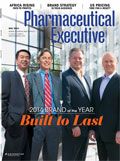Reimbursement Limits Threaten Drug Access
Pharmaceutical Executive
Despite provisions in the Affordable Care Act that require qualified health plans to cover 'basic' benefits, access to prescription drugs may be limited by high out-of-pocket costs and tight pharmacy management strategies.
More than 7 million Americans may be gaining healthcare coverage through Obamacare, but that doesn't mean they will be able to obtain needed medicines. Despite provisions in the Affordable Care Act (ACA) that require qualified health plans to cover "basic" benefits, access to prescription drugs may be limited by high out-of-pocket costs and tight pharmacy management strategies.

Jill Wechsler
These developments were discussed last month at the annual meeting of the Pharmaceutical Research and Manufacturers of America (PhRMA) in Washington, D.C. The need to better communicate the value of medicines and to shift the debate from costs and prices was a major theme. Speakers were optimistic about the enormous potential for new biopharmaceutical discovery, but predicted this could be limited by curbs on research funding and on drug reimbursement.
A report for PhRMA by Battelle put coverage and payment policies at the top of the list of issues predicted to limit biopharmaceutical innovation and industry growth over the next ten years. The recent administration proposal to drop certain "protected drug classes" in Medicare Part D is a sign of the problem, noted Robert Hugin, Celgene CEO and former PhRMA chairman, at a press briefing. He observed that high cost-sharing raises questions about whether new exchange plans will provide appropriate coverage, and whether these strategies will migrate to commercial plans.

Cost-sharing challenges
These concerns were highlighted at a panel on how health reform is reshaping pharmacy benefits, as exchange plans establish narrow formularies and specialty pharmacy tiers with steep coinsurance rates. Patient advocates cited plans that put all drugs for HIV/AIDS and hepatitis in the top specialty tier, which in some cases carry 50% coinsurance rates and excessive prior authorization requirements. And with out-of-pocket maximums exceeding $6,000 for low-cost bronze plans, many beneficiaries cannot afford needed medicines. These high cost-sharing benefit designs, moreover, could have "a ripple effect" if such strategies become "the norm" for commercial plans, noted Mark Velleca, executive VP at the Leukemia and Lymphoma Society.
Chet Burrell, CEO of CareFirst BlueCross BlueShield of Washington, D.C., Maryland, and Virginia, offered an alternative approach. He explained that insurers are looking for ways to better manage pharmacy spending, which now exceeds outlays for inpatient care for his organization with the rise in specialty medicines. Burrell explained that the ACA requiring guaranteed issue and community rating, insurers cannot offer lower rates to patients who adopt wellness programs that keep them out of hospitals.

What value in a $1,000 pill?
So CareFirst is proposing to control spending on patients with multiple chronic conditions by waiving cost sharing in 2015 for those very sick beneficiaries who agree to adhere to a special care management program supervised by a physician. He acknowledged that many actuaries fear this approach will fail to achieve savings. But if it works, Burrell predicted, others may adopt it.
Another strategy is for states and regulators to set tighter limits on cost-sharing. Maryland recently enacted a $150 limit on co-pays for specialty drugs, and other states are looking at similar measures. Such a policy sets a level playing field for insurers and may prevent a "race to the bottom" in the drug coinsurance department.
Yet, the federal government is leery about setting limits on cost-sharing for fear that will drive up premiums, noted Jonathan Blum, principal deputy administrator of the Centers for Medicare and Medicaid Services (CMS). He acknowledged concerns about "true access" to benefits and said that CMS will be monitoring how well plans comply with policies designed to prevent discrimination against older, sicker patients. CMS issued guidance last month advising insurers that compliance reviews will scrutinize marketing practices and benefit designs that deter less healthy individuals from purchasing a plan.
Yet, that's just what occurs with plans that place whole classes of necessary medicines in the specialty tier with high coinsurance, said Carl Schmid of The AIDS Institute, who urged CMS to do more to halt such tactics. If there's no enforcement now, he queried, "who will stop the 'good' plans this year from becoming 'bad plans' next year?"
Broader changes in pharmacy benefit design are needed, observed Jim Robinson, president of Astellas US. He recalled that tiered benefit plans gained traction under Medicare Part D, along with the $600 price definition for specialty drugs. He and others want to see that threshold revised upward, and co-pays replace coinsurance for pricey therapies.
Coupons & controls
Higher cost-sharing also puts pressure on pharma companies to maintain drug co-pay assistance programs, long sponsored by marketers to help low-income and uninsured patients obtain brand medicines. While co-pay vouchers and coupons are accepted by commercial plans, they are considered "kickbacks" to prescribers under government-funded programs such as Medicare and Medicaid.
Pharma companies may channel patient support through non-profits that independently dispense the assistance to needy individuals. But uncertainty about whether CMS considers plans sold on exchanges as "federal plans" that cannot accept industry financial assistance has prompted some manufacturers to hold off on co-pay assistance for ACA beneficiaries; other firms continue to offer co-pay support pending a clear CMS ruling that this is illegal.
Meanwhile, pharmacy benefit managers (PBMs) and insurers seek new strategies for controlling outlays for specialty meds, which are expected to reach $235 billion by 2018, according to a new report by Milliman for CVS Caremark. The analysts propose that insurers shift prescription drug coverage from medical to pharmacy benefits, which can better utilize formulary tiers and utilization management to control costs. Savings close to 20% would come from revising reimbursement strategies for certain self-administered drugs obtained from pharmacies, as opposed to doctors' offices. Such a shift, though, runs counter to pharma efforts to highlight how outlays for medications can reduce overall healthcare spending—and provide value to the healthcare system.

Jill Wechsler is Pharm Exec's Washington correspondent. She can be reached at jwechsler@advanstar.com
Navigating Distrust: Pharma in the Age of Social Media
February 18th 2025Ian Baer, Founder and CEO of Sooth, discusses how the growing distrust in social media will impact industry marketing strategies and the relationships between pharmaceutical companies and the patients they aim to serve. He also explains dark social, how to combat misinformation, closing the trust gap, and more.
